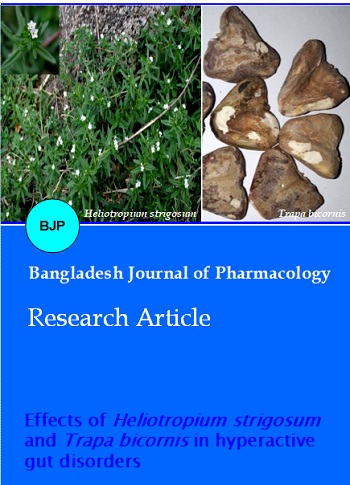Effects of Heliotropium strigosum and Trapa bicornis in hyperactive gut disorders
DOI:
https://doi.org/10.3329/bjp.v12i2.31694Keywords:
Heliotropium strigosum, Hyperactive gut disorder, Trapa bicornisAbstract
The current study was aimed to investigate the extracts from Heliotropium strigosum and Trapa bicornis phytochemically for various constituents and pharmacologically for gastro-intestinal disorders. Phytochemical analysis indicated the presence of alkaloids, flavonoids, glycosides and tannins in both the extracts. In castor oil-induced diarrhea, H. strigosum and T. bicornis, at 100-1000 mg/kg dose provided protection of 10-83% and 14-76% respectively. In isolated rabbit jejunum preparations, T. bicornis (0.01-5 mg/mL) relaxed the spontaneous and K+ (80 mM)-induced contractions with EC<sub>50</sub> values of 1.2 mg/mL and 2.6 mg/mL respectively, suggesting that spasmolytic effect was possibly mediated through calcium channel blockade. This was further authenticated when pretreatment of tissues with T. bicornis (1-5 mg/mL) caused rightward shift of Ca++ concentrationresponse curves, similar to verapamil. In acute toxicity test, both extracts were safe up to 10 g/kg dose. These results indicated the usefulness of H. strigosum and T. bicornis in the treatment of hyperactive gut disorders.
Downloads
1748
1047 Read
566

Published
How to Cite
Issue
Section
License
Authors who publish with this journal agree to the following terms:
- Authors retain copyright and grant the journal right of first publication with the work simultaneously licensed under a Creative Commons Attribution License that allows others to share the work with an acknowledgement of the work's authorship and initial publication in this journal.
- Authors are able to enter into separate, additional contractual arrangements for the non-exclusive distribution of the journal's published version of the work (e.g., post it to an institutional repository or publish it in a book), with an acknowledgement of its initial publication in this journal.
- Authors are permitted and encouraged to post their work online (e.g., in institutional repositories or on their website) prior to and during the submission process, as it can lead to productive exchanges, as well as earlier and greater citation of published work (See The Effect of Open Access).
